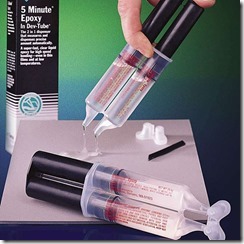Guest Post by Dr. R. Bruce Prime and Dr. John Avila
This post describes the kinetic equations used to characterize thermoset reactions that are autocatalytic in nature. The autocatalytic equations originate from a kinetic equation based on the chemistry of the epoxy-amine reaction and invoke assumptions that simplify the math. Epoxy-amine thermosets are in widespread use from 5-minute epoxy adhesives to matrix materials for advanced composites. They are also the most widely studied thermosets.
Referring to Schemes 1 and 2 in the previous post, the complete chemical equation, Eq. 1 below, is based on four discreet reactions: epoxy with primary amine catalyzed by alcohol produced in the cure reaction, epoxy with primary amine catalyzed by catalyst initially present, epoxy with secondary amine catalyzed by alcohol produced in the cure reaction, and epoxy with secondary amine catalyzed by catalyst initially present (see Ref. 1). k1, k’1, k2 and k’2 are the corresponding rate constants. The rate of consumption of epoxide dx/dt is given by
dx/dt = k1a1ex + k’1ec0 + k2a2ex + k’2a2ec0 (1)
where e is the molar concentration of epoxide, a1 the molar concentration of primary amine and a2 the molar concentration of secondary amine at time t. e0, a0, and c0 are initial concentrations of epoxide, primary amine and external catalyst. x is the epoxide consumed.
Assuming equal reactivity of all amine hydrogens and converting to a fractional concentration basis leads to the following autocatalytic equation (1)
dαEp/dt = (k1 + k2 αEp )(1-αEp)(B-αEp) (2)
where dαEp/dt is the rate of conversion of epoxide, αEp the fractional conversion of epoxide and B the ratio of amine hydrogen equivalents to epoxide equivalents. Note that the amine concentration αAm is represented by the term (B-αEp). Equation 2 will be used to model the effects of stoichiometry.
Ideally the only reaction is an epoxide with an amine. When stoichiometric quantities of reactants are mixed B = 1 and αEp = αAm = α, where α is the overall conversion in an amine-epoxide system. k1 is the rate constant for the externally catalyzed reaction[1] and k2 is the rate constant for the autocatalyzed reaction. Under these circumstances Eq. 2 reduces to
dα/dt = (k1 + k2 α)(1-α)2 (3)
This equation will be used to model stoichiometrically balanced reactions. It is also appropriate for the user who has control over, or at least knowledge of, the formulation. For thermosets of unknown composition one must resort to phenomenological equations based on the above considerations, such as
dα/dt = (k1 + k2 αm) (1-α)n (4)
which contains the four variables k1, k2, m and n. Users of thermosets who do not have access to their composition will find this equation, first attributed to Sourour and Kamal (2), useful for analyzing cure data.
It should be pointed out that when k1 = 0, Eqs. 2-4 describe purely autocatalytic behavior without any influence of external catalyst. In practice k1 can be small compared to k2 but will have a finite value due to unavoidable impurities in the starting materials or even absorbed water. It should also be noted that when k2 = 0 these equations revert to nth order equations, broadening their applicability. For example Eq. 4 becomes
dα/dt = k1 (1-α)n (5)
which described the 2nd order cure of a fast-reacting polyurethane with n = 2 (see Part 6 of this series A Practical Example of Cure Kinetics in Action).
In the next blog post we will describe the mathematical approaches taken to generate model cure data from Equations 2 and 3, as well as to fit cure data, eg from DSC or FTIR studies, to Eq. 4
_____________
[1] k1 encompasses an underlying rate constant for the epoxy-amine reaction, eg k’1, times the concentration of external catalyst, eg k1 = k’1c0.
References
- K. Horie et al., J. Polym. Sci., Polym. Chem. Ed. 8, 1357 (1970).
- S. Sourour and M. R. Kamal, Thermochim. Acta 14, 41 (1976).


Leave a Reply